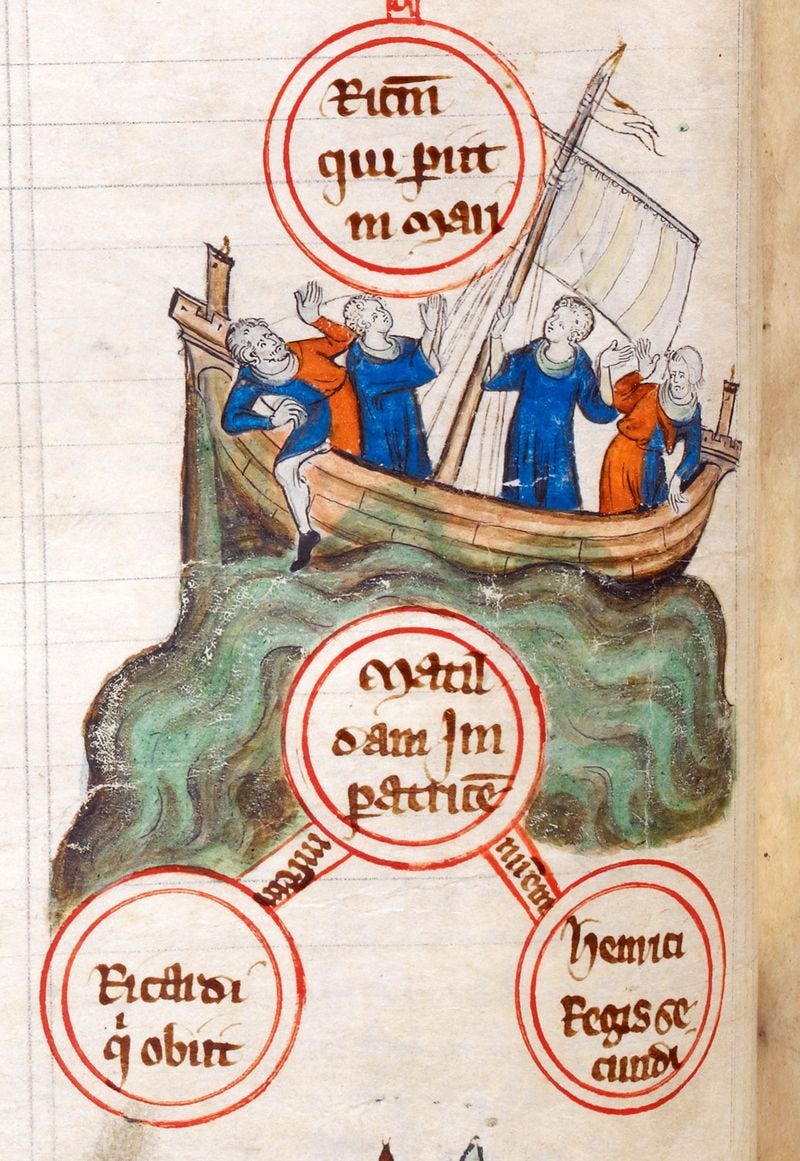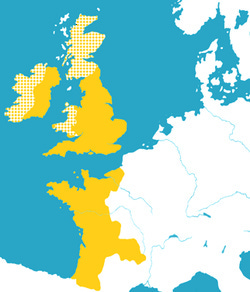Long-running institutions generally produce two things that appeal to my nerd brain: one is lists; the other is errata. Should anti-popes really be included in the full complement of Bishops of Rome? Was John Hurt a proper Doctor Who? Hours of fun to be had.
One list with which I have been familiar since childhood is the one that inspired the annoying mnemonic that starts, “Willie, Willie, Harry, Stee”. There’s a clear and uncontested list of kings and queens of England and the dates on which they ruled, and if we’re more familiar with the membership of that list after the Norman conquest than we are with those that came before, we do at least know that there is a list.
But half of the fun of learning about history lies in the discovery that things are never quite as simple as you thought. That familiar list is, if not exactly wrong, then at the very least incomplete. Here are some people who don’t tend to make the official list but still had good reason to think of themselves as monarch of England, along with their regnal dates.
Ælfweard (924): Second son of the great king Edward the Elder; may have briefly reigned after his father’s death (the relevant chronicles are divided). Even if he did, though, he died within a few weeks, to be succeeded by his brother Æthelstan, who was the first to call himself “King of the English”.
So, it’s not clear Ælfweard ruled something one might call “England”, it’s not clear he ruled at all, and also, let’s be honest, if I chucked a bunch of vowels together with a couple of Ws and told you they’d been an anglo-saxon king of England, you probably couldn’t confidently tell me I was lying. On the whole, then, an underwhelming start.
Edgar Ætheling (1066): A distant cousin of Edward the Confessor, grandson of Edmund II Ironside, elected king by the “Witan” – a sort of ruling council – after the Norman Conquest of October 1066. But his supporters can’t have been that enthusiastic about his claim: firstly, they’d not pushed it when Edward’s death created a succession crisis the previous January; secondly, they all wussed out the moment they came across any heavily armed Normans. Edgar, too, swiftly paid homage to William the Conqueror, which was probably sensible because it meant he got to live to a ripe old age, rather than being brutally murdered by some French Norwegians at some point in his early teens.
Now we’re getting to the good stuff.
Matilda (1141): Has a claim to be England’s first reigning queen. The daughter of Henry I, she was left as an only child after her younger brother died – alongside most of the court – when the White Ship sank in the channel, an event so disastrous and hilarious all at the same time that Daniel Mallory Ortberg once wrote about it under the headline, “Embarrassing Succession Crises In History: The Twelfth-Century Titanic”.

Anyway. Matilda probably knew a lot about power politics – she was an empress, married first to the Holy Roman Emperor Henry V, then to the count of Anjou – but 12th century England wasn’t quite ready for feminism, and her cousin Stephen seized the crown before she could. She did manage to control England for seven months during the civil war known as The Anarchy; but ultimately had to accept Stephen’s reign, in exchange for recognition of her son’s right to succeed him as Henry II.
Henry the Young King (1170-83): That same Henry II crowned his eldest surviving son as co-king while he was still very much moving about, in an attempt to avoid the kind of succession crises that had dogged England for centuries (a trick that Roman emperors used to pull, with the cheery result that, when the coup inevitably came, the plotters just killed the son, too). The older Henry seemed to have planned to divide his cross-channel empire among his sons.

This would probably have been a good plan, except the younger Henry got the hump that his crown came with no actual power, and in 1173 raised an army to overthrow his father. The two made it up, but a decade later he rebelled again, this time going to war against his brother Richard the Lionheart, too. Then he died of dysentery, so that solved that problem.
Louis (1216-17): Three of Henry II’s sons would be crowned king of England: the two I’ve already mentioned, plus John, who was so bad at it that basically everyone rebelled.
You already know that story – Magna Carta et al. – but what you might not know is that he was so bad at it that the King of France invaded and was welcomed in London with open arms. Barely a month after being proclaimed king in St Paul’s Cathedral, Louis VIII of France controlled half of England and had the support of most of the barons. A couple of months later, John gave into popular pressure and copied his older brother by, yes, dying of dysentery.
The following year, supporters of John’s baby son Henry III beat Louis in battle, then said that they’d give him a load of gold if he said he’d never been rightful king of England after all and went away again. Louis liked gold. So he did.
Jane (1553): By the mid 16th century, the English monarchy had come of age. Succession crises caused simply by squabbling siblings were out; succession crises caused by squabbling siblings convinced they had god on their side were in.
So as the young Edward VI lay dying, he re-wrote his will to exclude his suspiciously Catholic half-sister Mary as illegitimate, and ensure the crown would go to his firmly protestant cousin, Lady Jane Grey. Jane was declared queen, and hung around in the Tower of London – always a mistake – awaiting her coronation for a week and a bit.
The problem was, it quickly became blindingly obvious that the country preferred Mary: after just nine days, she was declared queen, deposing Jane by default. Initially, the new queen showed some mercy towards her cousin, executing her father but merely holding her nine-day predecessor prisoner in the Tower. By the next year, though, it was obvious that Jane’s continued existence as a focus for protestant rebellion was going to be a pain, so Mary had her executed, too.
That same year, Mary married, giving us one last disputed king:
Philip (1554-8): Make no mistake: under the terms of Philip II of Spain’s marriage to Mary, he was definitely King of England. The two monarchs were depicted on coins together; all state business was enacted in Spanish or Latin, because the king didn’t speak English. Denying his royal authority was an act of treason.
Unfortunately, though, his wife died, childless, in 1558, which under the terms of their arrangement meant Philip no longer counted as king. As England moved more firmly into the anti-Catholic camp, it became a bit embarrassing to acknowledge the existence of King Philip. So, we just stopped. And now, treasonous bunch that we are, we act like he was never king at all.
If our definition of a disputed monarch is “someone who thought of themselves as king or queen”, then surely there’s a case for James III & VIII, the Old Pretender, the son of James II? But if I get onto the Jacobite Succession we’ll be here all week so perhaps this is where we should get off.
Subscribe now or the puppy gets it
The article above is an extract from the archive of the Newsletter of (Not Quite) Everything, a weekly newsletter which goes out every Wednesday at 4pm. Readers of this week’s edition could read a chapter cut from my upcoming book, regarding what the “midwest” and manifest destiny teach us about imperialism; and enjoy some maps highlighting the difficulty some delivery companies have in understand the word “mainland”.
Why not bite the bullet and become a paying subscriber? Every Wednesday afternoon, you’ll get a bit on politics, some diverting links, an article on something from history/geography/language/whatever I’ve been obsessing about this week, and the map of the week. You’ll also a warm glow of satisfaction that you’re helping me to write fun and interesting things, not nasty corporate ones. And all for just £4 a month or £40£28 a year! Can’t say fairer than that now can I, Rodney.
BUT: we’re all broke right now. If you can’t currently justify paying for some nerd’s substack (unemployed, underemployed, impoverished student, and so forth), just hit reply and ask nicely and I’ll give you a complimentary subscription, no questions asked. I am literally giving it away.
Alternatively, if why not pre-order my new book, out next April? Go on, it’ll encourage the bookshops to get excited about the thing.


